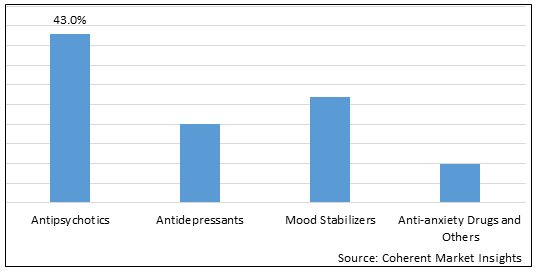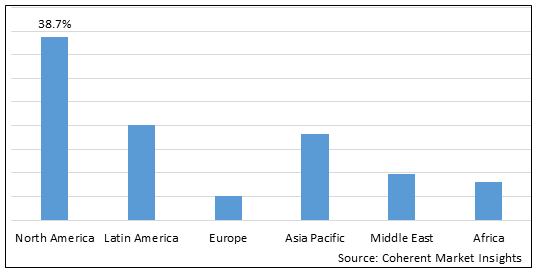Bipolar Disorder treatment Market is estimated to be valued at USD 9,701.6 Mn in 2025 and is expected to reach USD 14,019.3 Mn in 2032, exhibiting a compound annual growth rate (CAGR) of 5.4% from 2025 to 2032.
Analysts’ Views on Global Bipolar Disorder Treatment Market:
The increasing prevalence of bipolar disorder, increased government activities to raise awareness, and technological improvements for bipolare disorder treatment are the main drivers of market expansion for this condition and is expected to drive the global bipolar disorder treatment market over the forecast period. For instance, according to an article published in October 2021, titled "What is the worldwide prevalence of bipolar disorder?" bipolar disorder has an approximate lifetime prevalence of 1% and an approximate one-year prevalence of 0.5% worldwide. There are more cases of bipolar I disorder than bipolar II condition. The World Health Organization (WHO) essential statistics revised in June 2022, stated that 1 in every 8 individuals worldwide suffers from a mental condition. In 2020, the number of persons who experience anxiety and depressive disorders will significantly grow as a result of the COVID-19 pandemic. Initial predictions point to an increase in anxiety and depressive disorders of 26% and 28% in just one year, respectively. 40 million people will have bipolar disorder in 2020, according to the same estimate. Alternating moods are common among those with bipolar illness.
Figure 1. Global Bipolar Disorder Treatment Market Share (%), By Drug Class, 2025

To learn more about this report, Download Free Sample
Global Bipolar Disorder Treatment Market – Driver
Increasing product approvals are expected to propel the market growth over the forecast period
To treat adults with schizophrenia and as adjunctive therapy to lithium or valproate for the maintenance treatment of bipolar disorder in adults, the key market players are focusing on getting product approvals from regulatory authorities is expected to drive the bipolar disorder treatment market over the forecast period. For instance, in January 2023, Luye Pharma Group, an international pharmaceutical company, announced it had received FDA approval for its Rykindo (risperidone), which is an extended-release injectable suspension administered via intramuscular injection once every two weeks.
Figure 2. Global Bipolar Disorder Treatment Market Value (US$ Million), By Region, 2025

To learn more about this report, Download Free Sample
Global Bipolar Disorder Treatment Market- Regional Analysis
Among regions, North America is estimated to hold a dominant position in the global bipolar disorder treatment market over the forecast period. North America holds 38.7% of the market share. The market is anticipated to increase rapidly over the forecast period due to rising bipolar disorder cases and improved healthcare infrastructure. Around 1 in 5 adults in the U.S. experience mental illness in a given year, according to data from the National Alliance on Mental Illness. Severe maniacal and depressive episodes necessitate hospitalization to prevent individuals from hurting themselves or others. According to the National Institute of Mental Health (NIMH), manic episodes that are so severe that a person needs emergency medical care are one of the characteristics of bipolar I disorder.
Global Bipolar Disorder Treatment Market – Impact of Coronavirus (COVID-19) Pandemic
Since the COVID-19 virus outbreak in December 2019, the disease spread to over 100 countries across the globe, and the World Health Organization declared it a public health emergency on January 30, 2020.
COVID-19 affected the economy in three main ways: by directly affecting the production and demand of drugs, by creating disruptions in distribution channels, and through its financial impact on firms and financial markets. Due to nationwide lockdowns, several countries such as China, India, Saudi Arabia, the U.A.E., Egypt, and others are facing problems with the transportation of drugs from one place to another.
However, the COVID-19 pandemic had a minor negative impact on the global bipolar disorder treatment market. For instance, in September 2021, an article published ‘Implications of the COVID-19 pandemic for people with bipolar disorders: A scoping review’, focused on how the clinical course of bipolar disorder (BD) is affected by social isolation, stifling rules, lifestyle changes, and biological circadian rhythm abnormalities brought on by the COVID-19 pandemic, or infection-related worries. According to several research, persons with bipolar disorder (BD) experienced fewer relapses or symptoms that worsened during the pandemic, or less severe psychiatric symptoms and greater feelings of well-being than they had before the pandemic. Patients with bipolar disorder (BD) showed less psychological discomfort than those with major depressive disorder (MDD).
Bipolar Disorder Treatment Market Report Coverage
| Report Coverage | Details | ||
|---|---|---|---|
| Base Year: | 2024 | Market Size in 2025: | USD 9,701.6 Mn |
| Historical Data for: | 2020 To 2024 | Forecast Period: | 2025 To 2032 |
| Forecast Period 2025 to 2032 CAGR: | 5.4% | 2032 Value Projection: | USD 14,019.3 Mn |
| Geographies covered: |
|
||
| Segments covered: |
|
||
| Companies covered: |
Takeda Pharmaceutical Company Limited, Pfizer, Inc., Allergan plc, Otsuka Holdings Co. Ltd., Johnson & Johnson, Eli Lilly and Company, GlaxoSmithKline plc, AstraZeneca Plc, Novartis International AG, AbbVie Inc., H. Lundbeck A/S, Minerva Neurosciences, Sumitomo Dainippon Pharma Co., Ltd., Intra-Cellular Therapies Inc., Gedeon Richter Plc., and Indivior PLC |
||
| Growth Drivers: |
|
||
| Restraints & Challenges: |
|
||
Uncover macros and micros vetted on 75+ parameters: Get instant access to report
Global Bipolar Disorder Treatment Market Segmentation:
The global bipolar disorder treatment market report is segmented into, drug class, distribution channels, and region
Based on Drug Class, the market is segmented into antipsychotics, antidepressants, mood stabilizers, and anti-anxiety drugs and others. Out of which, the antipsychotics segment is expected to hold a dominant position in the global bipolar disorder treatment market during the forecast period and this is attributed to the increasing prevalence of bipolar disorders.
Based on Distribution Channel, the market is segmented into hospital pharmacies, retail pharmacies, and online pharmacies. Out of which, the hospital pharmacies segment is expected to dominate the market over the forecast period and this is attributed to the increase in the number of product launches for the management of bipolar disorder over the forecast period.
Among all segmentation, the drug class segment has the highest potential due to the increasing prevalence of bipolar disorder over the forecast period. For instance, according to the article published in March 2022, "Prevalence and Clinical Correlates of Medical Disorders in Patients with Bipolar Disorder," medical problems are very common in Chinese with bipolar disorder (BD). Comorbidities in BD patients are related to smoking, frequency of depressive episodes, age of onset, and disease duration. Clinicians should be aware of comorbidities in BD patients and take appropriate measures to improve treatment outcomes and reduce suffering.
Global Bipolar Disorder Treatment Market Cross Sectional Analysis:
In drug class segment, antidepressant drugs hold a dominant segment in North America region. The key players are focusing on increasing access to capital to continue the development of its innovative drug pipeline targeting Central Nervous System (CNS)/Psychiatry and Respiratory Disease, by adopting growth strategies such as agreement and merger, which will drive the growth of the global bipolar disorder treatment market. For instance, in December 2020, NeuroRx, Inc., a clinical-stage, small molecule pharmaceutical company, and Big Rock Partners Acquisition Corp., a special purpose acquisition company, entered into an agreement and plan of merger to increase the development of novel therapeutics for the treatment of COVID-19 and Bipolar Depression.
Global Bipolar Disorder Treatment Market: Key Developments
Increasing contribution to the growth of global bipolar disorder treatment market by various research and development activities
Increasing research and development activities for the treatment of schizophrenia and acute treatment of manic or mixed episodes associated with bipolar disorder is expected to drive the bipolar disorder treatment market growth over the forecast period. For instance, in December 2021, Zydus Cadila, a pharmaceutical company, gets the U.S. Food and Drug Administration (U.S. FDA) approval to market the generic drug Cariprazine capsules, which are used in the treatment of schizophrenia.
Global Bipolar Disorder Treatment Market: Restraint
Side effects associated with drugs
Side effects associated with drugs used in the treatment of bipolar disorder are expected to be a factor negatively affecting the growth of the market up to a certain extent, as patients hesitate to undergo medication therapy due to fear of the same. For instance, some of the medications including carbamazepine, Divalproex sodium, and Lithium used in the treatment of bipolar disorder have some side effects such as nausea, tremors, sexual problem, impaired memory, muscle weakness, decreased thyroid function, liver and kidney damage, skin reactions, and others.
Global Bipolar Disorder Treatment Market - Key Players
Major players operating in the global bipolar disorder treatment market Takeda Pharmaceutical Company Limited, Pfizer, Inc., Allergan plc, Otsuka Holdings Co. Ltd., Johnson & Johnson, Eli Lilly and Company, GlaxoSmithKline plc, AstraZeneca Plc, Novartis International AG, AbbVie Inc., H. Lundbeck A/S, Minerva Neurosciences, Sumitomo Dainippon Pharma Co., Ltd., Intra-Cellular Therapies Inc., Gedeon Richter Plc., and Indivior PLC
*Def- Bipolar disorder, also known as manic illness, is a brain disorder that affects mood, energy level, and other activities. This disorder consists of various episodes, and the major among these are manic and depression. There is a sudden change in the mood of the patient and his/her ability to carry out daily tasks. There are four types of bipolar disorders: bipolar I, bipolar II, cyclothymic, and other specified and non-specified bipolar and related disorders.
Share
Share
About Author
Ghanshyam Shrivastava - With over 20 years of experience in the management consulting and research, Ghanshyam Shrivastava serves as a Principal Consultant, bringing extensive expertise in biologics and biosimilars. His primary expertise lies in areas such as market entry and expansion strategy, competitive intelligence, and strategic transformation across diversified portfolio of various drugs used for different therapeutic category and APIs. He excels at identifying key challenges faced by clients and providing robust solutions to enhance their strategic decision-making capabilities. His comprehensive understanding of the market ensures valuable contributions to research reports and business decisions.
Ghanshyam is a sought-after speaker at industry conferences and contributes to various publications on pharma industry.
Missing comfort of reading report in your local language? Find your preferred language :
Transform your Strategy with Exclusive Trending Reports :
Frequently Asked Questions
Select a License Type
Joining thousands of companies around the world committed to making the Excellent Business Solutions.
View All Our Clients